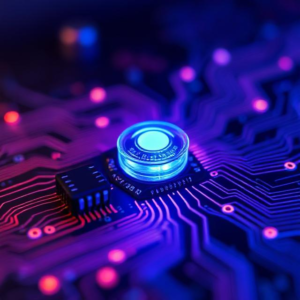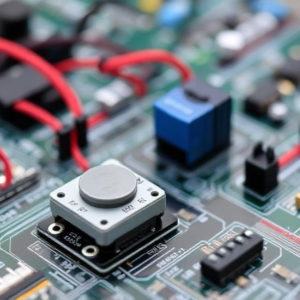What are Smart Sensors?
A smart sensor is a type of sensor that can sense or measure things (like temperature, pressure, or motion) and process that information on its own. Unlike regular sensors that just detect something and send the data somewhere, smart sensors are “smarter” because they can also analyze or interpret the data, make decisions, and even communicate that information to other devices or systems.

Components of a Smart Sensor:
- Sensing Element: The part that actually detects the physical quantity (like a temperature or motion sensor).
- Signal Processing: The part that processes the raw data from the sensor and converts it into a useful form (like digital signals or information that can be analyzed).
- Communication Interface: This is how the sensor sends its processed information to other systems (like a computer, machine, or cloud platform) for monitoring or control.
How Do Smart Sensors Work in Industrial Applications?
In industries (like manufacturing, energy, or logistics), machines and equipment need to constantly monitor and adjust based on their environment. Smart sensors are used in these applications to make the process more efficient, automated, and safer. Here’s how it works:
- Sense: The sensor detects physical quantities such as temperature, humidity, pressure, speed, or vibration.
- Process: The smart sensor processes the detected data, analyzes it, and makes simple decisions.
- Communicate: It sends the processed data or decision to a control system or other devices to take action or alert operators.
Examples of Smart Sensors in Industrial Applications:
- Temperature Sensors:
- What they do: These sensors measure temperature, and with smart technology, they can adjust settings automatically based on the temperature reading.
- Example in industry: In a factory that manufactures products requiring specific temperatures, a smart temperature sensor can detect if the temperature is too high or low and then automatically adjust the heating or cooling systems.
- Pressure Sensors:
- What they do: Pressure sensors measure pressure in pipes, tanks, or machinery. Smart pressure sensors can not only measure pressure but also detect trends and predict potential failures.
- Example in industry: In oil or gas pipelines, a smart pressure sensor can monitor pressure levels. If pressure gets too high or low, it can trigger an alarm or automatically adjust valves to prevent equipment damage.
- Vibration Sensors:
- What they do: These sensors measure vibrations in machines or equipment, which can indicate issues like wear and tear, imbalance, or failure.
- Example in industry: In an industrial motor, a smart vibration sensor can detect abnormal vibrations, analyze the frequency, and send a maintenance request to prevent breakdowns.
- Proximity Sensors:
- What they do: These sensors detect the presence or absence of an object, or measure its distance.
- Example in industry: In a manufacturing line, a smart proximity sensor can detect whether a part has been placed on the assembly line. If something goes wrong, it can send a signal to halt production or alert the operator.
- Humidity Sensors:
- What they do: These sensors measure the level of humidity in the air, which is important in industries where moisture levels affect product quality.
- Example in industry: In food storage, smart humidity sensors can ensure that the moisture levels are optimal. If the levels are too high or low, the sensor can adjust the ventilation system to keep the conditions stable.
- Gas Sensors:
- What they do: Gas sensors can detect the presence of hazardous gases (like carbon monoxide, methane, or oxygen).
- Example in industry: In chemical factories or mines, smart gas sensors can continuously monitor the air for harmful gases. If dangerous levels are detected, the sensor can trigger alarms or activate ventilation systems.
Benefits of Smart Sensors in Industry:
- Increased Efficiency: Since smart sensors can process data and make quick decisions on their own, they help automate tasks, leading to faster and more efficient operations.
- Predictive Maintenance: Smart sensors can detect early signs of wear or problems in equipment. For example, a smart vibration sensor can predict when a machine might fail, so maintenance can be done before a breakdown happens, saving money on repairs and preventing downtime.
- Improved Accuracy: Smart sensors can provide very precise measurements and can adjust automatically when conditions change. This is especially important in industries where small changes can have a big impact on product quality or safety.
- Remote Monitoring: Since smart sensors can communicate their data to a central system, they enable remote monitoring. Operators can keep an eye on various systems and machines without being physically present, which is great for efficiency and safety.
- Safety: Smart sensors can help keep workers safe by detecting hazardous conditions like gas leaks, high temperatures, or excessive pressure. They can automatically shut down machines or alert workers before accidents happen.
- Energy Efficiency: By monitoring things like temperature, humidity, or energy usage, smart sensors can help companies optimize their processes and reduce energy consumption, leading to cost savings and environmental benefits.
Communication Technologies Used by Smart Sensors:
Smart sensors often use different technologies to communicate the data they collect:
- Wired Communication: Some sensors use traditional wired connections (like Ethernet or RS-485) to send data to control systems.
- Wireless Communication: Many smart sensors use wireless technologies like Wi-Fi, Bluetooth, Zigbee, or LoRa to send data over the air. This is especially useful in hard-to-reach places or when you want to minimize wiring.
Real-World Example of Smart Sensors in Industry:
Smart Factory: In a modern “smart factory,” smart sensors are used everywhere:
- Temperature sensors control the ovens.
- Vibration sensors monitor motors.
- Pressure sensors ensure hydraulic systems are operating correctly.
- Humidity sensors maintain optimal conditions for product storage.
All the data from these sensors is sent to a central system that analyzes it, makes decisions, and adjusts operations automatically. This leads to faster production, fewer mistakes, and reduced downtime.
In Summary:
Smart sensors in industrial applications are advanced sensors that can sense, process, and communicate data on their own. They are used in many industries to monitor conditions like temperature, pressure, vibration, and more. They make processes more efficient, safer, and help predict maintenance needs before problems occur. With their ability to analyze data and communicate it, smart sensors help automate and improve industrial systems.











